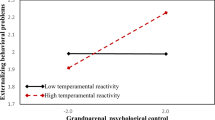Abstract
Investigation of the Type A Behavior Pattern (TABP) of pre-school children was conducted to determine the influence of the mother-child relationship on the development of TABP. The incidence of TABP was 44.2% (51.7% in boys and 38.7% in girls). The TABP tendency of the boys decreased as the manifest dissension or conflict in the family grew, in marked contrast with the tendency seen in girls, suggesting that conflict in the family can either weaken or reinforce TABP.
Similar content being viewed by others
References
Friedman M, Rosenman RH: Association of specific overt behavior pattern with blood cardiovascular findings.J. Am. Med. Ass. 96: 1286–1296, 1959.
Jenkins GD, Rosenman, RH, Zyzanski SJ: Prediction of clinical coronary heart disease by a test for the coronary-prone behavior pattern.New Eng J Med 290: 1271–1275, 1974.
Haynes SG, Feinleib M, Kannel WB: The relationship of psychosocial factors to coronary heart disease in the Framingham study: III. Eight-year incidence of coronary heart disease.Am J Epidemiol 111: 37–58, 1980.
Matthews KA, Angulo J: Measurement of the Type A behavior pattern in children: assessment of children's competitiveness, impatience-anger, and aggression.Child Develop 51: 466–475, 1980.
Matthews, KA, Avis NE: Stability of overt Type A behaviors in children: results from a one-year longitudinal study.Child Develop 54: 1507–1512, 1983.
Fukunishi I, Okabe S, Sasamori N: Stress of middle age:from the relationship between type A behavior pattern and stress.Jpn J Clin Psychol 4: 23–26 1991.
Rosenman RH, Chesney MA: Stress, Type A Behavior and coronary disease. In:Handbook of Stress, ed. Goldberger L. & Brezmitz S. New York: Macmillan, 1982.
Corrigan SA, Moskowitz DS: Type A behavior in preschool children: construct validation evidence for the MYTH.Child Develop 54: 1513–1521, 1983.
Matthews KA, Volkin J: Efforts to excel and the Type A behavior pattern in children.Child Develop 52: 1283–1289, 1981.
Moos RH, Moos BS:Family environment scale manual (second edition). Palo Alto: Consulting Psychologists Press, 1986.
Saito S: Family environmental scale: a comparison of Japanese and American alcoholic families. The 5th Congress of the International Society for Biomedical Research on Alcholism, 232, 1990.
Frerichs RR, Webber LS, Voors AW, Srinivasan SR, Berenson GS: Cardiovascular disease risk factor variables in children at two successive years: the Bogalusa Heart Study.J Chronic Dis 32; 251–262, 1979.
Author information
Authors and Affiliations
Rights and permissions
About this article
Cite this article
Fukunishi, I., Saito, S. & Fujito, K. Influence of the mother-child relationship on the development of the Type A Behavior Pattern. Child Psych Hum Dev 22, 213–220 (1992). https://doi.org/10.1007/BF00705893
Received:
Revised:
Accepted:
Issue Date:
DOI: https://doi.org/10.1007/BF00705893




